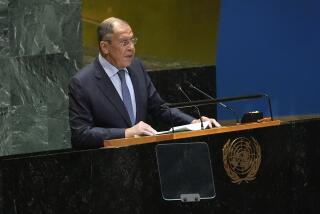Now Who’s to Be Deterred? : Nuclear: Small arms should be scrapped; they’re more lethal in today’s destabilized climate.
- Share via
MOSCOW — The elimination of tactical nuclear weapons is at the core of President Bush’s initiative, but this raises much broader questions about the strategies of deterrence.
The rationale was as follows: If deterrence fails and war in Europe begins, small-size tactical nuclear weapons probably would be the first to be fired.
The implacably hostile and ever battle-ready Soviet Union would be the one to start an offensive. But it was also believed that even the most evil Soviet Union would be deterred by the prospect of its army being instantly met with nuclear shells and short-range missiles.
Any use of nuclear weapons would escalate and inflict unimaginable damage on both sides. But to make a war more destructive was also to make it less likely.
The Soviet Union was perceived to be rational enough to accept such logic. There was also no doubt that it exercised highly centralized command over its nuclear forces.
Deterrence concepts were tailored to meet the Soviet threat of the past, and they are not flexible enough to be useful in entirely different circumstances. Many experts understood this when the domestic changes in the Soviet Union dramatically transformed the situation in Europe.
After the momentous developments following the attempted putsch in the Soviet Union, Cold War requirements for deterrence became dangerously obsolete.
The division of Europe has ended, but in place of East-West confrontation there is growing destabilization in the Balkans and almost endemic nationalism. If an all-European war should explode again, it may start not with a premeditated aggression, but as an escalation of a Yugoslavia-type crisis. There is no way to deter such a conflict with any kind of nuclear weapons.
The Soviet Union, or Russia, or other Soviet republics allied together lack both the intention and the capabilities to mount a massive attack against the West. The Soviet army is more preoccupied with housing its soldiers after the pullout from Eastern Europe; Soviet leaders are concerned about prospects for Western economic assistance rather than NATO’s military threat.
However, the old ruthless and threatening Soviet Union has not simply been replaced by a benevolent nation. Its place has been taken by a shattered country with a dozen independent-minded republics within its confines--and with nuclear weapons scattered throughout its territory.
Domestic politics in the Soviet Union all too often look irrational, making obsolete a key assumption of deterrence strategies: There is no way to deter an irrational opponent, such as a fiercely nationalistic leader or paranoid dictator.
The central authority still tightly controls Soviet nuclear weapons, but there are too many of these weapons for anybody’s comfort in a country embroiled in chaos. Tactical nuclear weapons stored in military depots may be an unreachable but still attractive target for the most extreme nationalistic groups ready to use even nuclear blackmail to achieve their goals.
A radical solution to this problem is to destroy tactical nuclear weapons. It would probably take too many years to negotiate elimination of all of them. Politically, it would also be very difficult for the Soviet leaders to do it unilaterally, thus provoking a new counterattack from conservatives and other hard-liners, who accused Mikhail Gorbachev and Eduard Shevardnadze of a sell-out so many times.
President Bush’s initiative opens up a welcome opportunity to cut this knot without major delays and without adding strain to an already overheated domestic situation in the Soviet Union.
And President Gorbachev has made it clear that the Soviet Union will not lose this opportunity and will match the unilateral steps of the United States.
Domestic transformation of the Soviet Union has raised a number of questions related to strategic weapons as well. The best way to address them is to eliminate a large part of the stockpiles and restructure the rest in order to ensure their ultimate safety and international security.
The United States and the Soviet Union were preparing for a war if deterrence failed, but most of their assumptions have been overtaken by peace. Still, there are vast opportunities for unilateral decisions on both sides, as well as negotiated solutions.
More to Read
Sign up for Essential California
The most important California stories and recommendations in your inbox every morning.
You may occasionally receive promotional content from the Los Angeles Times.










